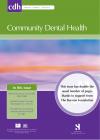Community Dental Health

- Cover Date:
- March 2011
- Print ISSN:
- 0265 539X
- Vol:
- 28
- Issue:
- 1
Oral hygiene and gingival health in Flemish pre-school children
Objectives: The study aimed to describe oral hygiene habits, oral hygiene status and gingival health in Flemish pre-school children and to explore factors associated with these clinical oral health variables. Methods: Cross-sectional data from 1,071 3-year-old and 1,119 5-year-old children from four geographical areas in Flanders (Belgium) were analysed. Buccal plaque accumulation and gingival health were assessed on six index teeth. Data on oral hygiene and dietary habits, oral health behaviour and socio-demographic variables were obtained through questionnaires. Results: 34% of 3-year-olds and 25% of 5-year-olds started brushing before the age of one, 17% of 3-year-olds and 23% of 5-year-olds brushed twice a day. Roughly, 30% of 3-year-olds and 37% of 5-year-olds presented with visible plaque accumulation. In both age groups, only 3 to 4% of children presented with signs of gingival inflammation. Multiple logistic regression models revealed that in both age groups children whose mothers had a college or university degree, had a smaller chance of presenting with visible plaque than children whose mothers had a lower educational level. With gingival health as dependent variable, multiple logistic regression analysis confirmed the major association between bacterial plaque accumulation and the presence of gingivitis. In the oldest age group, children’s former exposure to passive smoking was also significantly associated with gingivitis. Conclusion: Parents should be motivated to start brushing at an early age and brush thoroughly in order to maintain good oral health in their off-spring. Special attention should go to children raised by mothers with a lower educational level.
Key words: Dental plaque, gingival health, gingivitis, oral hygiene, pre-school children, primary dentition.
- Article Price
- £15.00
- Institution Article Price
- £
- Page Start
- 75
- Page End
- 81
- Authors
- R Leroy, A Jara, L Martens, D Declerck
Articles from this issue
- Title
- Pg. Start
- Pg. End
- The caries experience of 5 year-old children in Scotland, Wales and England in 2007-2008 and the impact of consent arrangements. Reports of co-ordinated surveys using BASCD criteria
- 5
- 11
- The dilemma of selecting suitable proximal carious lesions in primary molars for restoration using ART technique.
- 12
- 16
- Using laser fluorescence (DIAGNOdent) in surveys for the detection of noncavitated occlusal dentine caries
- 17
- 21
- The prevalence of and risk factors for non-carious cervical lesions in adults in Hubei Province, China
- 22
- 28
- Health-related lifestyle behaviours, socio-demographic characteristics and use of dental health services in Greek adults.
- 47
- 52
- Periodontal health and treatment needs among hospitalized chronic psychiatric patients in Istanbul, Turkey
- 69
- 74
- Comparison of the COHIP and OHIP- 14 as measures of the oral health-related quality of life of adolescents
- 82
- 88
- Assessment and comparison of periodontal status among young smokers and nonsmokers of Bangalore, India - a cross sectional study.
- 89
- 94
- Smoking and drinking habits and attitudes to smoking cessation counselling among Tanzanian dental students
- 95
- 98
- Traumatic dental injuries to primary incisors and the terminal or occlusal plane relationship in Indian preschool children
- 104
- 106
- Teaching dental public health to undergraduates using community profiles and patient case studies
- 116
- 120
